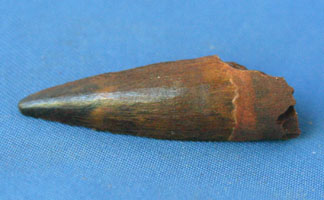Spinosaurus (means "spine lizard") was a theropod dinosaur which lived in North Africa. They lived during the Albian and Cenomanian Stages of the Cretaceous Period (112-97 million years ago).
Spinosaur was the largest of all carniverous dinosaurs; even larger than Tyrannosaurus rex. They were estimated to be about 41-59 feet long and weighed 7-23 tons. Their skulls were long and narrow, similar to that of a crocodile. They are thought to have lived on land and in the water and to have eaten fish similar to today's crocodiles. The spines of Spinosaurus were extensions of its vertebrae and grew to about five feet long with skin between them forming a sail-like structure. Some paleontologists believe there may have been fat and other tissue between the spines, forming a hump. Either way, the sail or hump may have served as a way to heat or cool the body and for display. It may have also allowed the Spinosaur to appear to larger and more intimidating.
Kingdom: Animalia, Phylum: Chordata, Class: Reptilia, Sub-Class: Dinosauria, Order: Theropoda, Sub-order: Megalasauria, Family: Spinosauridae, Sub-Family: Spinosaurinae, Genus: Spinosaurus, Species: moroccanus.
Spinosaurus moroccanus - tooth 
Quantity in Basket: None
Code: TMSM-109
Price: $30.00
Shipping Weight: 0.19 pounds
Time: Cretaceous, Maastrichtian Age - approximately 70 million years ago.
Location: Kem Kem Phosphate Beds, Khourigba, Morocco
Dimensions: 1-1/4" x 3/8" x 1/4"